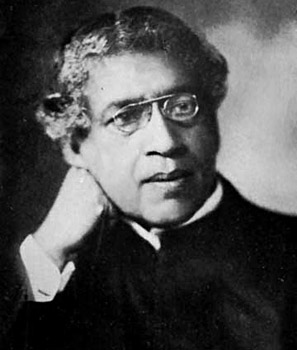Sir Jagadish Chandra Bose,(30 November 1858 – 23 November 1937) was a polymath, physicist, biologist, biophysicist, botanist and archaeologist, as well as an early writer of science fiction.Living in British India, he pioneered the investigation of radio and microwave optics, made very significant contributions to plant science, and laid the foundations of experimental science in the Indian subcontinent.IEEE named him one of the fathers of radio science.He is considered the father of Bengali science fiction. He also invented the crescograph. A crater on the moon has been named in his honour.
Born in Munshiganj, Bengal Presidency during the British Raj,Bose graduated from St. Xavier’s College, Calcutta. He then went to the University of London to study medicine, but could not pursue studies in medicine because of health problems. Instead, he conducted his research with the Nobel Laureate Lord Rayleigh at Cambridge and returned to India. He then joined the Presidency College of University of Calcutta as a Professor of Physics. There, despite racial discrimination and a lack of funding and equipment, Bose carried on his scientific research. He made remarkable progress in his research of remote wireless signalling and was the first to use semiconductor junctions to detect radio signals. However, instead of trying to gain commercial benefit from this invention, Bose made his inventions public in order to allow others to further develop his research.
Bose subsequently made a number of pioneering discoveries in plant physiology. He used his own invention, the crescograph, to measure plant response to various stimuli, and thereby scientifically proved parallelism between animal and plant tissues. Although Bose filed for a patent for one of his inventions because of peer pressure, his reluctance to any form of patenting was well known. To facilitate his research, he constructed automatic recorders capable of registering extremely slight movements; these instruments produced some striking results, such as Bose’s demonstration of an apparent power of feeling in plants, exemplified by the quivering of injured plants. His books include Response in the Living and Non-Living (1902) and The Nervous Mechanism of Plants (1926).
His major contribution in the field of biophysics was the demonstration of the electrical nature of the conduction of various stimuli (e.g., wounds, chemical agents) in plants, which were earlier thought to be of a chemical nature. These claims were later proven experimentally.He was also the first to study the action of microwaves in plant tissues and corresponding changes in the cell membrane potential. He researched the mechanism of the seasonal effect on plants, the effect of chemical inhibitors on plant stimuli and the effect of temperature. From the analysis of the variation of the cell membrane potential of plants under different circumstances, he hypothesised that plants can “feel pain, understand affection etc.”
Bose’s place in history has now been re-evaluated. He is now credited with inventing the first wireless detection device, discovering millimetre length electromagnetic waves, and being a pioneer in the field of biophysics.
Many of his instruments are still on display and remain largely usable now, over 100 years later. They include various antennas, polarisers, and waveguides, which remain in use in modern forms today.
To commemorate his birth centenary in 1958, the JBNSTS scholarship programme was started in West Bengal. In the same year, India issued a postage stamp bearing his portrait.
On 14 September 2012, Bose’s experimental work in millimetre-band radio was recognised as an IEEE Milestone in Electrical and Computer Engineering, the first such recognition of a discovery in India.
(Ref:https://en.wikipedia.org/wiki/Jagadish_Chandra_Bose & www.ajcbosecollege.org)
